医学专业英语 阅读一分册 第二章
医学专业英语阅读02
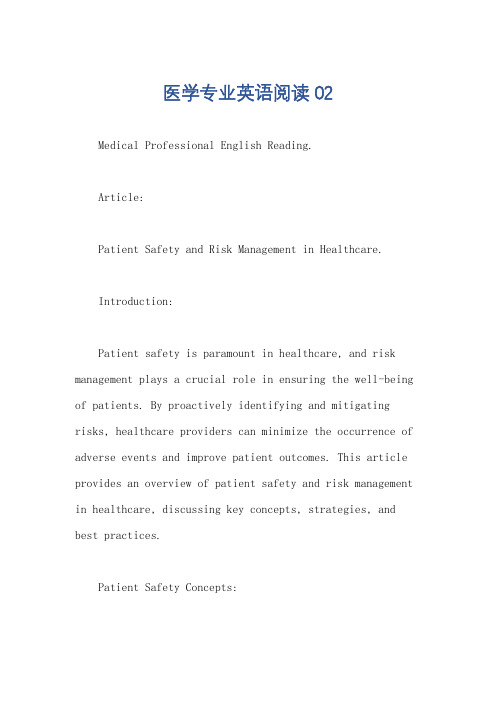
医学专业英语阅读02Medical Professional English Reading.Article:Patient Safety and Risk Management in Healthcare.Introduction:Patient safety is paramount in healthcare, and risk management plays a crucial role in ensuring the well-being of patients. By proactively identifying and mitigating risks, healthcare providers can minimize the occurrence of adverse events and improve patient outcomes. This article provides an overview of patient safety and risk management in healthcare, discussing key concepts, strategies, and best practices.Patient Safety Concepts:Patient Safety: The prevention of harm to patients arising from healthcare delivery.Adverse Event: An unanticipated or undesirable incident that could have resulted in harm to a patient.Near Miss: An incident that could have resulted in harm but did not cause actual injury.Root Cause Analysis: A systematic investigation to identify the underlying factors that contributed to an adverse event.Risk Management Strategies:Risk Assessment: Identifying and evaluating potential risks in healthcare processes and systems.Risk Management Plan: Developing strategies to mitigate or eliminate identified risks.Incident Reporting and Monitoring: Collecting andanalyzing data on adverse events and near misses to identify trends and areas for improvement.Patient Education: Empowering patients to participate in their own safety by providing them with information and tools.Teamwork and Communication: Fostering collaboration and open communication among healthcare professionals to minimize errors.Best Practices for Patient Safety:Use of Evidence-Based Practices: Implementing guidelines and protocols based on scientific evidence to minimize risks.Standardization of Processes: Streamlining processes to reduce variability and improve reliability.Technology Integration: Utilizing technology such as electronic health records and barcoding systems to enhancesafety and reduce errors.Safety Culture: Creating an environment where patient safety is prioritized and errors are not tolerated.Continuous Improvement: Regularly reviewing and updating patient safety practices based on data and feedback.Role of Healthcare Professionals:Physicians: Responsible for assessing patient risks, developing treatment plans, and coordinating care.Nurses: Monitor patients, administer medications, and provide patient education.Pharmacists: Ensure the safe and appropriate use of medications.Other Healthcare Providers: Contribute to patient safety through their specific roles and expertise.Conclusion:Patient safety and risk management are essential components of delivering high-quality healthcare. By understanding these concepts, implementing strategies, and embracing best practices, healthcare professionals can create a culture of safety and protect patients from harm. Continuous monitoring, evaluation, and improvement of patient safety practices are crucial for ensuring optimal patient outcomes.。
医学英语(阅读一分册)翻译及答案

Chapter 1Passage 1 Human BodyIn this passage you will learn:1. Classification of organ systems2. Structure and function of each organ system3. Associated medical termsTo understand the human body it is necessary to understand how its parts are put together and how they function. The study of the body's structure is called anatomy; the study of the body's function is known as physiology. Other studies of human body include biology, cytology, embryology, histology, endocrinology, hematology, immunology, psychology etc.了解人体各部分的组成及其功能,对于认识人体是必需的。
研究人体结构的科学叫解剖学;研究人体功能的科学叫生理学。
其他研究人体的科学包括生物学、细胞学、胚胎学、组织学、内分泌学、血液学、遗传学、免疫学、心理学等等。
Anatomists find it useful to divide the human body into ten systems, that is, the skeletal system, the muscular system, the circulatory system, the respiratory system, the digestive system, the urinary system, the endocrine system, the nervous system, the reproductive system and the skin. The principal parts of each of these systems are described in this article.解剖学家发现把整个人体分成骨骼、肌肉、循环、呼吸、消化、泌尿、内分泌、神经、生殖系统以及感觉器官的做法是很有帮助的。
医学专业英语 阅读一分册 第一,二,三章翻译(passage one).doc
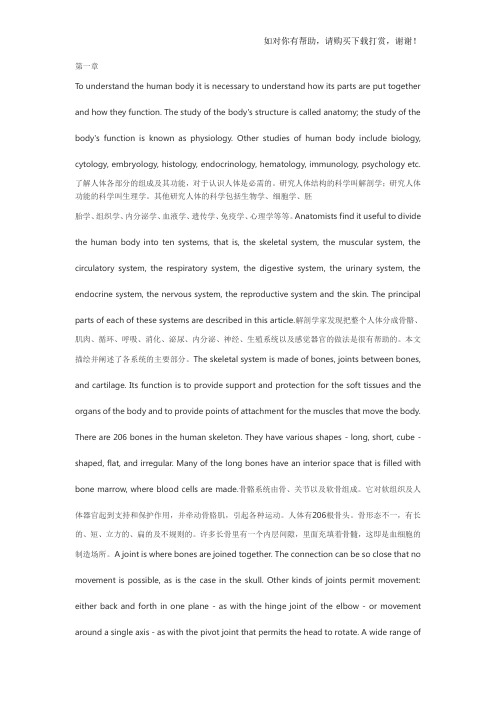
第一章To understand the human body it is necessary to understand how its parts are put together and how they function. The study of the body's structure is called anatomy; the study of the body's function is known as physiology. Other studies of human body include biology, cytology, embryology, histology, endocrinology, hematology, immunology, psychology etc.了解人体各部分的组成及其功能,对于认识人体是必需的。
研究人体结构的科学叫解剖学;研究人体功能的科学叫生理学。
其他研究人体的科学包括生物学、细胞学、胚胎学、组织学、内分泌学、血液学、遗传学、免疫学、心理学等等。
Anatomists find it useful to divide the human body into ten systems, that is, the skeletal system, the muscular system, the circulatory system, the respiratory system, the digestive system, the urinary system, the endocrine system, the nervous system, the reproductive system and the skin. The principal parts of each of these systems are described in this article.解剖学家发现把整个人体分成骨骼、肌肉、循环、呼吸、消化、泌尿、内分泌、神经、生殖系统以及感觉器官的做法是很有帮助的。
医学英语(阅读一分册)翻译与答案解析
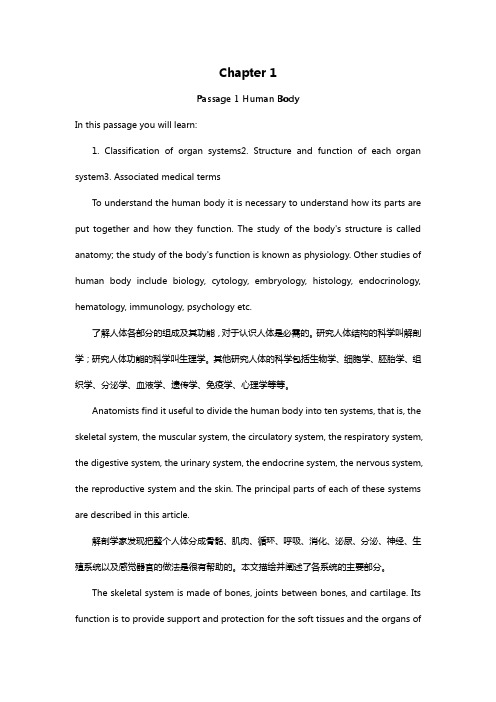
Chapter 1Passage 1 Human BodyIn this passage you will learn:1. Classification of organ systems2. Structure and function of each organ system3. Associated medical termsTo understand the human body it is necessary to understand how its parts are put together and how they function. The study of the body's structure is called anatomy; the study of the body's function is known as physiology. Other studies of human body include biology, cytology, embryology, histology, endocrinology, hematology, immunology, psychology etc.了解人体各部分的组成及其功能,对于认识人体是必需的。
研究人体结构的科学叫解剖学;研究人体功能的科学叫生理学。
其他研究人体的科学包括生物学、细胞学、胚胎学、组织学、分泌学、血液学、遗传学、免疫学、心理学等等。
Anatomists find it useful to divide the human body into ten systems, that is, the skeletal system, the muscular system, the circulatory system, the respiratory system, the digestive system, the urinary system, the endocrine system, the nervous system, the reproductive system and the skin. The principal parts of each of these systems are described in this article.解剖学家发现把整个人体分成骨骼、肌肉、循环、呼吸、消化、泌尿、分泌、神经、生殖系统以及感觉器官的做法是很有帮助的。
医学专业英语阅读一分册第二版答案

医学专业英语阅读一分册第二版答案1、51.People usually ________ the prices before they buy something. [单选题] *A.receiveB.payC.spendD.compare(正确答案)2、—Who came to your office today, Ms. Brown?—Sally came in. She hurt ______ in P. E. class. ()[单选题] *A. sheB. herC. hersD. herself(正确答案)3、( ) What other books have you read___ this English novel? [单选题] *A. besides(正确答案)B. exceptC.inD. about4、More than one student_____absent from the class yesterday due to the flu. [单选题] *A.areB.hasC.isD.was(正确答案)5、39.—What do you ________ my new dress?—Very beautiful. [单选题] *A.look atB.think aboutC.think of(正确答案)D.look through6、--_______ I borrow these magazines?--Sorry, only the magazines over there can be borrowed. [单选题] *A. MustB. WouldC. May(正确答案)D. Need7、—______ is the concert ticket?—It’s only 160 yuan.()[单选题] *A. How manyB How much(正确答案)C. How oftenD. How long8、Tony is a quiet student, _______ he is active in class. [单选题] *A. soB. andC. but(正确答案)D. or9、I couldn’t find Peter,_____did I know where he had gone. [单选题] *A.nor(正确答案)B.eitherC.neverD.as10、Reading()the lines, I dare say that the government are more worried than they admitted. [单选题] *A. behindB. between(正确答案)C. alongD. among11、She returns home every year to _______ the Spring Festival. [单选题] *A. celebrate(正确答案)B. shareC. watchD. congratulate12、I took?some _______of the Great Wall?in China last year. [单选题] *A. potatoesB. tomatoesC. photos(正确答案)D. paintings13、The storybook is very ______. I’m very ______ in reading it. ()[单选题] *A. interesting; interested(正确答案)B. interested; interestingC. interested; interestedD. interesting; interesting14、How many subjects are you _______ this year? [单选题] *A. takesB. takeC. taking(正确答案)D. took15、I _____ of her since she left school three years ago. [单选题] *A. didn’t hearB. haven’t heard(正确答案)C. was not hearingD. shall not heard16、You can borrow my book, _____ you promise to give it back to me by the end of this month. [单选题] *A.even ifB. as long as(正确答案)C. in caseD. even though17、Since the war their country has taken many important steps to improve its economic situation. [单选题] *A. 制定B. 提出C. 讨论D. 采取(正确答案)18、The three guests come from different _______. [单选题] *A. countryB. countrysC. countryesD. countries(正确答案)19、I like this house with a beautiful garden in front, but I don't have enough money to buy _____. [单选题] *A. it(正确答案)B. oneC. thisD. that20、Tony can _______ the guitar.Now he _______ the guitar. [单选题] *A. play; plays(正确答案)B. playing; playingC. plays; is playingD. play; is playing21、Don't tell me the answer, I'll work out the problem _____. [单选题] *A .by meB. myself(正确答案)C. meD. mine22、Will you see to()that the flowers are well protected during the rainy season? [单选题] *A. it(正确答案)B. meC. oneD. yourself23、We have _______ a double room with a bath for you in the hotel. [单选题] *A. boughtB. reserved(正确答案)C. madeD. taken24、I don't know the man _____ you are talking about. [单选题] *A. who'sB. whose(正确答案)C. whomD. which25、58.—How much is Lucy's skirt?—She________320 yuan for it. I think it's a little dear. [单选题] *A.tookB.paid(正确答案)C.spentD.bought26、—Where ______ you ______ for your last winter holiday?—Paris. We had a great time. ()[单选题] *A. did; go(正确答案)B. do; goC. are; goingD. can; go27、He has made a lot of films, but ____ good ones. [单选题] *A. anyB. someC. few(正确答案)D. many28、( ) You had your birthday party the other day,_________ [单选题] *A. hadn't you?B. had you?C. did you?D. didn't you?(正确答案)29、45.—Let's make a cake ________ our mother ________ Mother's Day.—Good idea. [单选题] *A.with; forB.for; on(正确答案)C.to; onD.for; in30、65.There is a big sale on in the shop! Every-thing is ________ price. [单选题] *A.bigB.fullC.zeroD.half(正确答案)。
医药英语教程第二单元课文翻译
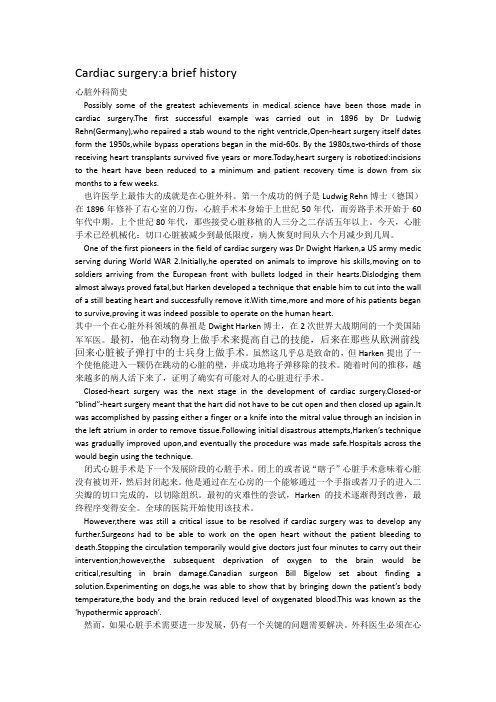
Cardiac surgery:a brief history心脏外科简史Possibly some of the greatest achievements in medical science have been those made in cardiac surgery.The first successful example was carried out in 1896 by Dr Ludwig Rehn(Germany),who repaired a stab wound to the right ventricle,Open-heart surgery itself dates form the 1950s,while bypass operations began in the mid-60s. By the 1980s,two-thirds of those receiving heart transplants survived five years or more.Today,heart surgery is robotized:incisions to the heart have been reduced to a minimum and patient recovery time is down from six months to a few weeks.也许医学上最伟大的成就是在心脏外科。
第一个成功的例子是Ludwig Rehn博士(德国)在1896年修补了右心室的刀伤,心脏手术本身始于上世纪50年代,而旁路手术开始于60年代中期。
上个世纪80年代,那些接受心脏移植的人三分之二存活五年以上。
今天,心脏手术已经机械化:切口心脏被减少到最低限度,病人恢复时间从六个月减少到几周。
One of the first pioneers in the field of cardiac surgery was Dr Dwight Harken,a US army medic serving during World WAR 2.Initially,he operated on animals to improve his skills,moving on to soldiers arriving from the European front with bullets lodged in their hearts.Dislodging them almost always proved fatal,but Harken developed a technique that enable him to cut into the wall of a still beating heart and successfully remove it.With time,more and more of his patients began to survive,proving it was indeed possible to operate on the human heart.其中一个在心脏外科领域的鼻祖是Dwight Harken博士,在2次世界大战期间的一个美国陆军军医。
医学英语(阅读一分册)翻译及答案

Chapter 1Passage 1 Human BodyIn this passage you will learn:1. Classification of organ systems2. Structure and function of each organ system3. Associated medical termsTo understand the human body it is necessary to understand how its parts are put together and how they function. The study of the body's structure is called anatomy; the study of the body's function is known as physiology. Other studies of human body include biology, cytology, embryology, histology, endocrinology, hematology, immunology, psychology etc.了解人体各部分的组成及其功能,对于认识人体是必需的。
研究人体结构的科学叫解剖学;研究人体功能的科学叫生理学。
其他研究人体的科学包括生物学、细胞学、胚胎学、组织学、内分泌学、血液学、遗传学、免疫学、心理学等等。
Anatomists find it useful to divide the human body into ten systems, that is, the skeletal system, the muscular system, the circulatory system, the respiratory system, the digestive system, the urinary system, the endocrine system, the nervous system, the reproductive system and the skin. The principal parts of each of these systems are described in this article.解剖学家发现把整个人体分成骨骼、肌肉、循环、呼吸、消化、泌尿、内分泌、神经、生殖系统以及感觉器官的做法是很有帮助的。
医学英语(阅读一分册)翻译及答案
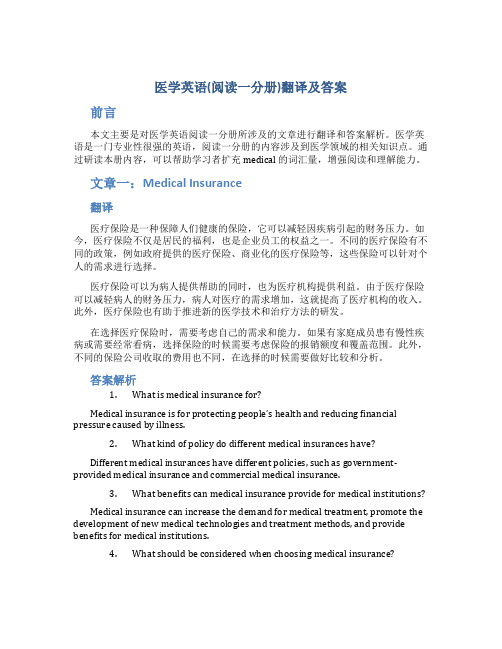
医学英语(阅读一分册)翻译及答案前言本文主要是对医学英语阅读一分册所涉及的文章进行翻译和答案解析。
医学英语是一门专业性很强的英语,阅读一分册的内容涉及到医学领域的相关知识点。
通过研读本册内容,可以帮助学习者扩充 medical 的词汇量,增强阅读和理解能力。
文章一:Medical Insurance翻译医疗保险是一种保障人们健康的保险,它可以减轻因疾病引起的财务压力。
如今,医疗保险不仅是居民的福利,也是企业员工的权益之一。
不同的医疗保险有不同的政策,例如政府提供的医疗保险、商业化的医疗保险等,这些保险可以针对个人的需求进行选择。
医疗保险可以为病人提供帮助的同时,也为医疗机构提供利益。
由于医疗保险可以减轻病人的财务压力,病人对医疗的需求增加,这就提高了医疗机构的收入。
此外,医疗保险也有助于推进新的医学技术和治疗方法的研发。
在选择医疗保险时,需要考虑自己的需求和能力。
如果有家庭成员患有慢性疾病或需要经常看病,选择保险的时候需要考虑保险的报销额度和覆盖范围。
此外,不同的保险公司收取的费用也不同,在选择的时候需要做好比较和分析。
答案解析1.What is medical insurance for?Medical insurance is for protecting people’s health and reducing financial pressure caused by illness.2.What kind of policy do different medical insurances have?Different medical insurances have different policies, such as government-provided medical insurance and commercial medical insurance.3.What benefits can medical insurance provide for medical institutions?Medical insurance can increase the demand for medical treatment, promote the development of new medical technologies and treatment methods, and provide benefits for medical institutions.4.What should be considered when choosing medical insurance?When choosing medical insurance, people should consider their own needs and capabilities, including the reimbursement limit and coverage range of the insurance as well as the fees charged by different insurance companies.文章二:Heart Health翻译心脏健康是人们健康的重要组成部分,然而最近的研究表明,越来越多的人患有心脏病。
- 1、下载文档前请自行甄别文档内容的完整性,平台不提供额外的编辑、内容补充、找答案等附加服务。
- 2、"仅部分预览"的文档,不可在线预览部分如存在完整性等问题,可反馈申请退款(可完整预览的文档不适用该条件!)。
- 3、如文档侵犯您的权益,请联系客服反馈,我们会尽快为您处理(人工客服工作时间:9:00-18:30)。
Human DiseasesThe brief survey of the human body in Chapter One has given us a glimpse into two different studies that are considered the fundamentals of medical sciences, namely anatomy and physiology. However, the picture is not complete without considering pathology, the science that deals with the structural and functional changes produced by the disease. In fact, the modern approach to the study of disorder emphasizes the close relationship of the pathological and physiological aspects and the need to understand the fundamentals of each in treating any body diseases.第一章中,通过对人体的概论,即解剖学与生理学,我们对两种被认为是医学基础的不同学科有了一个大致的印象。
然而如果我们不考虑病理学,这门涉及由疾病带来的结构和功能变化的学科,上述的人体概论就不是完整的。
实际上,现代对疾病的研究方法强调了病理学与生理学方面的密切关系,强调了我们在治疗任何人体疾病方面需要了解病理学与生理学基础的重要性。
Then what is a disease? It may be defined as a condition that impairs the proper function of the body or of one of its parts. Every living thing, both plants and animals, can succumb to disease. People, for example, are often infected by tiny bacteria, but bacteria, in turn, can be infected by even more minute viruses.那么什么是疾病呢?它可能被定义为正常的功能或是部分功能遭受损害时的一种状态。
每一种生物、植物和动物,都会受制于疾病。
例如,人类常常被微小的细菌所感染,但是,反过来说,细菌又能够被甚至更加微小的病毒所感染。
Hundreds of different diseases exist. Each has its own particular set of symptoms and signs, clues that enable a physician to diagnose the problem. A symptom is something a patient can detect, such as fever, bleeding, or pain. A sign is something a doctor can detect, such as a swollen blood vessel or an enlarged internal body organ.许多种疾病存在于世。
每一种都有其特定的症状、征兆和线索,医生能以此诊断疾病之所在。
症状是病人自己就能觉察到的,比如,高烧、流血,或是疼痛。
而征兆则是医生能够观察到的,比如,血管扩张或是体内器官肿大。
Diseases can be classified differently. For instance, an epidemic disease is one that strikes many persons in a community. When it strikes the same region year after year it is an endemic disease. An acute disease has a quick onset and runs a short course. An acute heart attack, for example, often hits without warning and can be quickly fatal. A chronic disease has a slow onset and runs a sometimes years-long course. The gradual onset and long course of rheumatic fever makes it a chronic ailment. Between the acute and chronic, another type is called subacute.疾病可以划分为不同的种类,例如,流行病是一种在某一社区内侵袭许多人的疾病。
当它年复一年地袭击同一社区,就成了一种地方病。
急性病发作快,但病程短,举个例子来说,急性心脏病发作常常没有前兆,而且会很快致命。
慢性病发作则慢,但病程有时会长达几年之久。
风湿热正是由于发病慢、病程长而成为一种慢性失调病(慢性病)。
而介于急性与慢性之间的另一种类型,就被称为亚急性。
Diseases can also be classified by their causative agents. For instance, an infectious, or communicable, disease is the one that can be passed between persons such as by means ofairborne droplets from a cough or sneeze. Tiny organisms such as bacteria and fungi can produce infectious diseases. So can viruses. So can tiny worms. Whatever the causative agent might be, it survives in the person it infects and is passed on to another. Sometimes, a disease-producing organism gets into a person who shows no symptoms of the disease. The asymptomatic carrier can then pass the disease on to someone else without even knowing he has it.疾病也可以依其病原体来划分,例如,传染病也叫作可传播的疾病,就是一种通过咳嗽和打喷嚏造成的空气小粒来传播的疾病。
极小的有机体,如,细菌和真菌可导致传染病。
病毒和小虫子也不例外。
不论病原体会是什么样,只要它存活于人体内就能够传染给别人。
有时,一个致病的有机体侵人人体后,该人却没有显示带病的症状。
于是无症状的病原携带者甚至在自己也不知情的情况下就把疾病传染给了他人。
Noninfectious diseases are caused by malfunctions of the body. These include organ or tissue degeneration, erratic cell growth, and faulty blood formation and flow. Also included are disturbances of the stomach and intestine, the endocrine system, and the urinary and reproductive systems. Some diseases can be caused by diet deficiencies, lapses in the body's defense system, or a poorly operating nervous system.非传染性疾病是由身体功能失调引起的。
这包括血管或组织退化、异常细胞生成,以及异常的血液生成和血液循环。
当然其中也包括胃、肠、内分泌系统和泌尿生殖系统的紊乱。
一些疾病也可能是由饮食不足、身体抵抗力下降、或是神经系统工作不造成的。
Disability and illnesses can also be provoked by psychological and social factors. These ailments include drug addiction, obesity, malnutrition, and pollution-caused health problems.心理因素和社会因素也会引发残废和疾病,这些病包括吸毒成性、肥胖、营养不良和由污染造成的健康问题。
Furthermore, a thousand or more inheritable birth defects result from alternations in gene patterns. Since tiny genes are responsible for producing the many chemicals needed by the body, missing or improperly operating genes can seriously impair health. Genetic disorders that affect body chemistry are called inborn errors of metabolism. Some forms of mental retardation are hereditary.而且,有上千种乃至为数更多的遗传性出生缺陷是由于基因变化而造成的。
由于小小的基因负责着生产许多身体所需的化学物质,它的遗失或是工作状态不良都会严重损害健康。
因基因失调而被影响了的身体化学反应被称之为先天性代谢失调。
